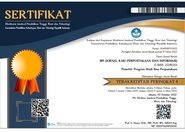PRESERVATION OF ORGANIZATIONAL KNOWLEDGE THROUGH DIGITALIZATION OF PERSONNEL ARCHIVES
Abstract
Keywords
Full Text:
PDFReferences
Abdhul Sadam. (2024). AI-driven archives: Revolutionizing the future of data preservation. Archives of Science, 8(6).
Ailakhu, U. V. (2024). Digital preservation strategies for historical records in the age of AI and the metaverse. Library Hi Tech News. Advance online publication.
Ardhia, D. R. M., & Prasetyawan, Y. Y. (2019). Pelestarian pengetahuan arsiparis di Badan Perencanaan Pembangunan, Penelitian dan Pengembangan Daerah Provinsi Jawa Tengah. Jurnal Ilmu Perpustakaan, 8(3), 59–70. https://ejournal3.undip.ac.id/index.php/jip/article/download/26823/23670
Barney, J. (1991). Firm resources and sustained competitive advantage. Journal of Management, 17(1), 99–120.
Booth, A., Sutton, A., & Papaioannou, D. (2016). Systematic approaches to a successful literature review. Sage.
Chaudhry, A. S., & Al-Samarraie, H. (2023). Digital curation and preservation in the age of big data and AI: Emerging issues and research directions. International Journal of Information Management, 69, 102694.
Chaudhry, A. S., & Jiun, L. C. (2005). Preserving knowledge in organizations: A case study of a Singapore company. Journal of Information & Knowledge Management, 4(3), 221–233.
Dalimunthe, AQ., Erwani, I & Syam, AM. (2025). A Model of Religious Harmonization in Indonesia: The Syncretic Dialectic of Tridharma and Islam. Pharos Journal of Theology 106 (4)
EffOCR Authors. (2023). Efficient OCR for building a diverse digital history. arXiv.
Eve, M. P. (2024). Digital scholarly journals are poorly preserved: A study of preservation coverage. Journal of Librarianship and Scholarly Communication, 12, 1–15.
Hanifah, F., & Setyaningsih, R. (2024). Management of dynamic archives for education personnel in State Madrasah Aliyah. Kharisma: Jurnal Administrasi dan Manajemen Pendidikan, 2(2), 136–144.
Haug, N. (2024). Digitally induced change in the public sector: Drivers, processes, and outcomes. Government Information Quarterly, 41(1), 101876.
Hernawan, D., Oktavinia, K., Pratidina, G., & Seran, G. G. (2024). Sistem pengarsipan digitalisasi dalam bidang kepegawaian. Karimah Tauhid, 3(1), 574–585. https://ojs.unida.ac.id/karimahtauhid/article/view/11673
Hurley, C. (2024). The power of provenance in the records continuum. Archives and Manuscripts, 52(1), 8–23.
Jeffry, J., Usman, S., Mardewi, M., & Asrhi, N. A. (2022). Digitalisasi arsip pegawai pada Badan Kepegawaian dan Pengembangan Sumber Daya Manusia Kab. Bone. Journal of System and Computer Engineering (JSCE), 3(2), 296–306. https://journal.unpacti.ac.id/JSCE/article/view/490
Kadek, K. A. (2023). Efektivitas pengelolaan arsip kepegawaian terhadap sistem temu kembali arsip pegawai di Badan Kepegawaian dan Pengembangan Sumber Daya Manusia Kabupaten Buleleng Provinsi Bali [Disertasi, IPDN]. http://eprints.ipdn.ac.id/15714/
Khairifa, F., Kholil, S., Syam, AM & Mujtahid, NM. (2025). Mitigating food waste and household waste management: The potential for redistributing surplus food in the policy communication of Medan City government. IOP Conference Series: Earth and Environmental Science 1445 (1), 012047
Kitchenham, B. (2004). Procedures for performing systematic reviews. Keele University Technical Report.
Lafia, S., et al. (2023). Digitizing and parsing semi-structured historical administrative records: Methods and evaluation. Journal of Documentation, 79(8), 160–179.
López-Muñoz, R., & García, F. (2024). Artificial intelligence applications in archives and records management: Opportunities and ethical challenges. Journal of Documentation, 80(2), 345–362.
Masrek , M. N. ., Baharuddin , M. F. ., & Syam , A. M. . (2025). Determinants of Behavioral Intention to Use Generative AI: The Role of Trust, Personal Innovativeness, and UTAUT II Factors. International Journal of Basic and Applied Sciences, 14(4), 378-390. https://doi.org/10.14419/44tk8615
Mosha, N. F. (2023). Metadata standard for continuous preservation, discovery and interoperability. Information, 14(8), 427.
Moher, D., Liberati, A., Tetzlaff, J., & Altman, D. G. (2009). Preferred reporting items for systematic reviews and meta-analyses: The PRISMA statement. PLoS Medicine, 6(7), e1000097.
Mursyidah, L., Sukmono, R., & Masithah, L. I. (2024). Transformation of digital archives management: Case study of dynamic archives information system implementation at SMA Negeri 2 Sidoarjo. Indonesian Journal of Public Administration Review, 1(4), 7.
Nasution, S. D. K., & Natas, A. M. (2024). The Indonesian education units use of digital archives for records management. Jurnal Manajemen Pendidikan, 15(1). https://journal.unj.ac.id/unj/index.php/jmp/article/view/51137
Nonaka, I., & Takeuchi, H. (1995). The knowledge-creating company: How Japanese companies create the dynamics of innovation. Oxford University Press.
Preserving the cultural heritage of Indonesian society through digital preservation in libraries. (2025). Knowledge Garden: International Journal of Library Studies, 3(1). https://jkg.ub.ac.id/index.php/jkg/article/view/32
Sayekti, R., Batubara, A. K., Aditya, M., Purwaningtyas, F., & Syam, A. M. (2021). When the" Library as Place" Matters: A Case Study of an Academic Library. Library Philosophy & Practice.
Snyder, H. (2019). Literature review as a research methodology: An overview and guidelines. Journal of Business Research, 104, 333–339.
Spencer, R. (2023). PREMIS: Events through an event-sourced lens. Code4Lib Journal, 59. https://journal.code4lib.org/articles/17689
Sumarni, S., & Mardhiah, N. (2021). Digitalisasi arsip kepegawaian pada Kantor BPKD Kabupaten Aceh Barat. COMSERVA: Jurnal Penelitian dan Pengabdian Masyarakat, 1(8), 426–433. https://comserva.publikasiindonesia.id/index.php/comserva/article/view/63
Syam, AM., Dalimunthe, MA., Suhendar, A & Rambe, RFAK. (2024). Islamic Philosophy: A Comparative Perspective Between Ibnu Khaldun And Karl Marx. SYAHADAT: Journal of Islamic Studies 1 (2), 55-72
Upward, F. (1996). Structuring the records continuum, Part one: Postcustodial principles and properties. Archives and Manuscripts, 24(2), 268–285.
Walsh, J. P., & Ungson, G. R. (1991). Organizational memory. Academy of Management Review, 16(1), 57–91. https://doi.org/10.5465/amr.1991.4278992
Wulandari, DA & Syam, AM. (2025). Analysis of The Availability of Braille Collections at The Public Library of Deli Serdang Regency Based on The Needs of The Visually Impaired. LITERACY: International Scientific Journals of Social, Education, Humanities 3 (3), 76-82
Zefanya, J. (2024). Digitalisasi arsip perusahaan e-commerce (Blibli) dengan menggunakan software SAP. LIVRE: Jurnal Perpustakaan dan Informasi, 1(1). https://jurnal.ut.ac.id/index.php/livre/article/view/9328
Zeldenrust, D. (2023). Across space and time: The Records Continuum Model and the collections of the Meertens Institute. In DH Benelux 2023 Conference Proceedings (pp. 1–10).
DOI: http://dx.doi.org/10.30829/jipi.v10i2.25842
Refbacks
- There are currently no refbacks.
Copyright (c) 2025 Vita Arieska

This work is licensed under a Creative Commons Attribution-ShareAlike 4.0 International License.










_1.png)
.png)
_.png)

